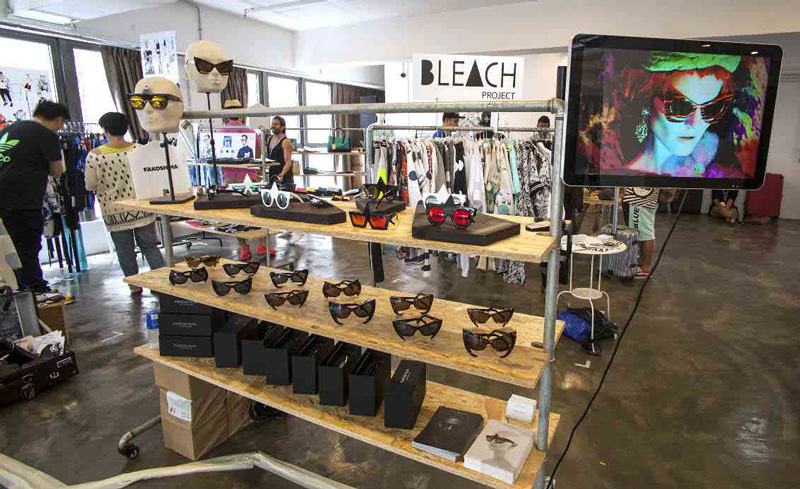For two days last week Lai Chi Kok was the unlikely location for the hip and happening in fashion.
Designers, buyers, and retailers descended on the warehouse district in Kowloon for the third edition of The Hub, one of Hong Kong’s most- watched fashion fairs and trade shows.
Started last year by Richard Hobbs and Peter Caplowe, The Hub was meant to be a non-traditional trade show for niche, mostly Western, fashion brands hoping to gain a presence in Asia. At the same time, they saw that multi-label stores were taking off in China and hoped The Hub would provide a forum for Asian retailers to meet international brands without having to travel to Europe or the US.
This year, however, things were different. Aside from relocating from the stultifying AsiaWorld-Expo halls to a trendier industry space in Lai Chi Kok, the biggest change was in the range of designers. The usual better-known European and American labels were there, but there was also a group of young designers from Asia.
“When we started, the vision was to bring international fashion brands to Asia,” says Hobbs. “The difference that we’ve seen [this year] is a lot of interest from both local and regional designers who needed a place to showcase themselves.”
On Wednesday, the first two floors where most of the American and European brands were located were fairly quiet. The real action was happening upstairs on the 10th floor at The Greenhouse, an area set aside for up-and-coming local designers along with bigger Asian names like Chinese designer Vega Zaishi Wang and Hong Kong designer Six Lee.
Dana Maulana, founder of Indonesian brand Danjyo Hiyoji, saw The Hub on YouTube at home in Jakarta. This is his first year taking part and he’s already making a splash. In the early afternoon, many buyers, mostly from the mainland, had expressed interest in his line.
While mainland buyers stalked the racks, European fashion fans eagerly pawed through collections of new local designs and crowded around Wang and Lee as they gave interviews for local television cameras.
The attention paid to local designers was a potent symbol of the changing trends among Asian consumers. Time and time again in conferences and talks, organised in conjunction with the China Fashion Forum, attendants were reminded that the days of blind mass consumption and label- obsession were over. On the mainland in particular, today’s consumers want clothes that emphasise their individuality. They flock to small brands and local designs.
These changes have encouraged local designers to jump into the mainland market, and led to a proliferation of small independent labels in China.
Hobbs remembers not too long ago, regional designers had to travel to Europe to court Asian retailers. Today, The Hub is in the bizarre position of
Take Nannan Kong. The Chinese designer has based her Lou de Nannan brand of funky, brightly coloured knitwear in Beijing, and though her clothes are carried in stores in many Chinese cities, she says she’s still more comfortable with the European market.
“Before, we [designers] lived in Paris and we started in Paris,” Kong says.
“I think I know the European market but I don’t really know the Asian market.”
Hong Kong designers such as Amy Cheung, the creative director of the Hong Kong brand Handkerchief, are also eager to establish a presence on the mainland but remain unsure of the Chinese consumer.
“I hope to be able to meet more Asian retailers and buyers because we have not been exposed to Asian markets,” Cheung says. “I always present in New York so we know people there but I actually don’t know so many people locally.”
Cheung is in a particularly tricky position. Her clothes are political, and often critical of China. Her trips to show in New York have been sponsored by the Hong Kong Trade and Economic Council, and she says one of the requirements
of her sponsorship was that she “would not show these political things”.
At The Hub, there were no such restrictions, and she decorated her booth proudly with a row of black T-shirts each sporting a large white letter.
Together they spelled, “Democracy is now here”.
She happily explained to passers-by that the idea for the shirts was inspired by a Hong Kong politician who was turned away at the Shenzhen border for wearing a pro-democracy shirt. With her shirts, a group of people could pass through customs unnoticed and later spell out the political message. Cheung makes no secret of her desire to subvert authority.
When it was suggested recently that she should not mention Hong Kong’s massive July 1 protests in China, she created
a top with a fringe of plastic tabs. On each tab, written in brail, were headlines relating to
July 1 from newspapers around the world.
She laughs off the suggestion that her political messages could be off-putting to mainland buyers.
“Asian retailers have been very interested,” she says. “I actually feel that China is very open.”
That, or maybe something has been lost in translation.
“I don’t think they get this yet,” she says, pointing to a shirt. “They don’t know English.”



